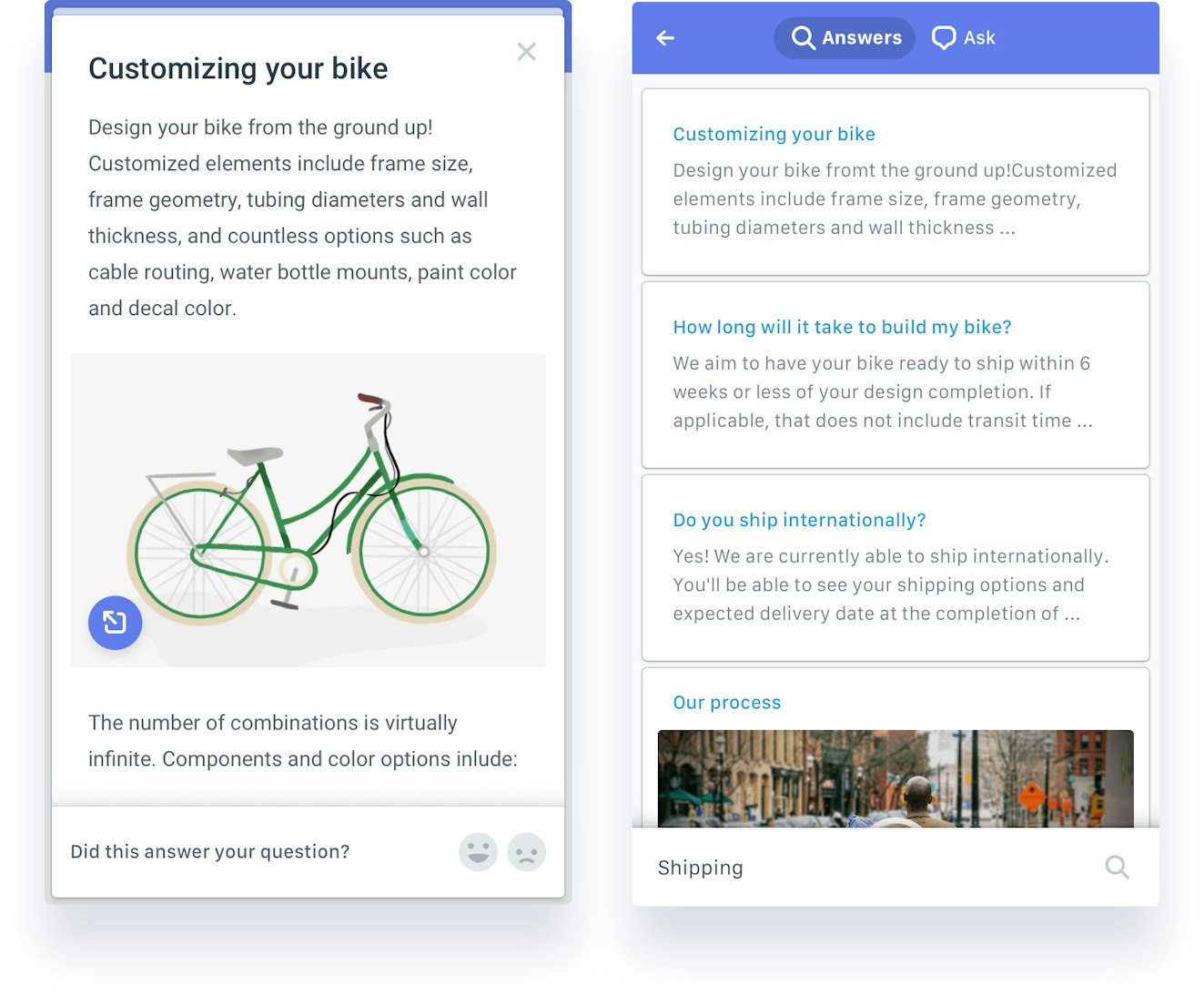There’s no static formula for what customers want. As technology evolves — and the way we interact with customers evolves with it — preferences change, too. Although fast, helpful customer support over phone and email used to be a differentiator, it’s not enough anymore.
Live chat software raised the bar with the expectation of instant, comprehensive help from customer support professionals. We’re raising the bar again by offering customers what they need before they reach out through a live chat solution, balancing intuitive self-service with personalized help.
This is a chapter in our Ultimate Guide to Live Chat Support. When you're ready, check out the other chapters:
Chapter 1 – Customer Service Live Chat: A Guide for 2025
Chapter 2 – Key Live Chat Statistics for Customer Service Teams
Chapter 3 – 101 Best Live Chat Response Examples for Customer Service
Chapter 4 – The Best Free Live Chat Software in 2025
Chapter 5 – The 12 Best Ecommerce Live Chat Tools
Chapter 6 – Actionable Live Chat Metrics to Start Tracking Today
What is contextual support?
We call our approach contextual support: giving customers answers to their questions wherever they are, whenever they need them.
Help Scout’s Beacon harnesses the full breadth of this super-powered self-service, anticipating needs and dishing out relevant content to customers before they’ve even asked a question.
Here’s why we think contextual support is the perfect partner for live chat software.
Contextual support improves live chat software interactions
Live chat solutions are awesome for customers — that’s why we made live chat the central component of Beacon 2.0. One survey showed that 75% of people prefer using live chat to making a phone call. Another showed that 51% of consumers are more likely to stay with or buy from a company if they offer live chat support. We love chat, too, because the benefits for everyone are clear.
Customer service chat software is a better alternative to phone calls for customer-centric companies that want to deliver personal, immediate service in a cost-effective way.
Not only are we now able to understand and resolve our customers’ questions more quickly and develop more personal relationships, we can achieve this interaction while managing multiple conversations at once. In terms of improving the efficiency of our response process, this is a big plus.

Dave Hole
Managing Director at Ovatu
But live chat support software’s outstanding accessibility and efficiency also set up some big challenges for everyone. Without layering a self-service integration into chat, you risk an unfulfilled promise to customers and can wear down team members. Contextual support is a win-win because it solves the two biggest challenges of customer chat software head-on with dynamic, flexible solutions.
Challenge #1: Customers ask before they look, and the support requests pile up
Because live chat software is so easy to use, it’s often the first option customers turn to. Have a question? Ask an expert without pulling your hands off the keyboard, and see an answer within seconds.
This approach may seem efficient for the customer, but it can quickly overwhelm support teams and disappoint customers.
Bombarded with simple questions — many of which are already addressed in the knowledge base — the support team struggles to deliver high value, which drains resources and morale. Likewise, long wait times or unresponsive teams can anger customers because they expect immediacy.

Unlike other live chat solutions, Beacon is a self-service tool first that draws on all of the outstanding content you’ve already created and repurposes it in relevant contexts. Leading with instant answers incentivizes customers to get the help they need in record time. By integrating self-service content into the live chat box, you can lower requests by 20-30%.
Before Beacon, most users that stumbled into our resource library did so after receiving a message from our team linking them to specific resources. Now, users can find these resources much more easily on their own. Beacon has really streamlined how our users find relevant resources, browse our content, and connect with our support team.

Carly Williams
Head of Product Support at Panorama Education
After checking out content, customers choose whether they want to live chat or send a message through the Help Desk. If no support team member is available, the status change is visible to anyone on the website, and customers can shoot the team a message instead.
Although many customers prefer chat, some would rather send a message and walk away from the app or website. Expanding rather than limiting their options means that you’re not forcing customers into real-time conversations. That way, your team can maintain an optimal support experience while integrating live chat support software into their day-to-day.
The solution: Customers get the answers they need through contextual support. If they still need help, they have the flexibility to choose the channel that’s right for them. Support teams can funnel their energy into more complex customer challenges.
Challenge #2: If customers always and only turn to chat, they’re missing out on an exceptional service experience
When customers need to open a live chat box to answer a simple question about a company’s product or service, the customer experience is already lacking. More than ever, people want an integrated experience and self-service options — contextual support makes that possible without a cookie-cutter approach.
With Beacon 2.0, customer support teams can tailor-build every aspect of the customer experience without having to code. In just a few minutes, support managers decide what they want people to see on a given page — from content and language, to design and functionality — without ever tapping developers.
The setup and learning curve were pretty effortless, which was a real breath of fresh air for us.

Sam Miller
Director of Operations at altMBA
By lowering the threshold to personalize every aspect of support, you can integrate contextual support directly into the user experience and live chat software any way you want. It makes a huge difference for customers.
Offering suggested articles that make sense in context (for example, showing different articles on our marketing site than we would in-app) gets folks to what they're looking for faster, and even helps us to answer questions people didn't know they had.

Alex Edwards
Senior Customer Operations Lead at Clerky
In any field, from e-commerce to real estate management, contextual support can transform the customer experience and boost business value far beyond time saved.
In e-commerce, for example, sharing answers about products and pricing in Beacon means that customers don’t have to leave the sales page to get the information they need. They’re a lot more likely to make the purchase if you can address any concerns — about the product, shipping, return policy, and process — in the moment.
The solution: Customers experience the most efficient, personalized support through self-service. Completely adaptable contextual support enhances the customer experience every time they visit your website or app.
Contextual support with Beacon
With Beacon 2.0, not only do customers get the information they need within a context — that information also gets shared with the support team, so everyone’s immediately up to speed on the problem that has to be solved. Support teams see data about the pages and articles a customer has visited and any past chats or tickets; customers never have to waste their time explaining all the same details over and over again.
Leveraging this kind of context for a personalized support experience is undoubtedly a great way to deliver above-and-beyond service. Without contextual support, it’s all too easy to get lured by one channel and lose sight of the ultimate goal: helping people every day in the most personal, efficient ways possible.






